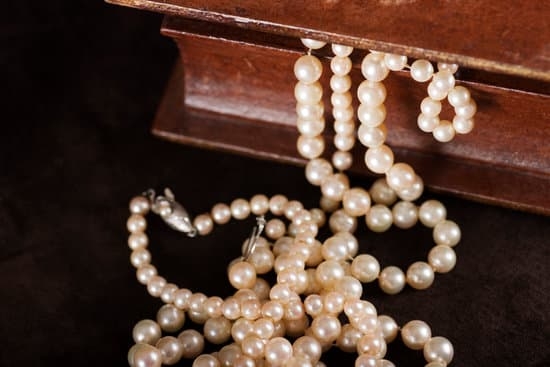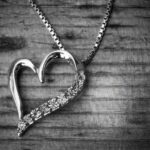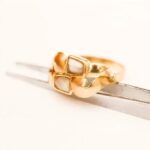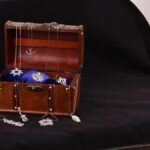Are pearls considered fine jewelry? This question often arises when discussing the classification of jewelry. In this article, we will delve into the world of fine jewelry and the significance of including pearls in this category. Pearls have been an emblem of elegance and sophistication for centuries, but are they truly considered fine jewelry?
Fine jewelry is characterized by its exceptional craftsmanship, use of high-quality materials, and timeless design. It is often associated with luxury and prestige, making it a coveted addition to any collection. The classification of pearls as fine jewelry holds great importance in the jewelry industry due to their historical significance and cultural value.
Throughout history, pearls have been revered for their natural beauty and rarity. From ancient civilizations to modern fashion trends, pearls have held a prominent place in the world of jewelry. Understanding the origins and evolution of pearls in jewelry is essential to appreciating their status as fine jewelry today.
History of Pearls in Jewelry
Pearls have a rich and fascinating history in the world of jewelry, dating back to ancient times. In many cultures, pearls were prized for their rarity and beauty, and were often reserved for royalty and the elite. From the Gulf of Mannar to the islands of the South Pacific, pearls have been harvested from the depths of the ocean and used to create exquisite jewelry pieces that have stood the test of time.
Ancient Times
In ancient Rome, pearls were a symbol of wealth and status and were often worn as a display of one’s affluence. The Greeks also revered pearls, believing that they were tears of joy shed by the goddess Aphrodite. In China, pearls symbolized wisdom and purity, while in India they were associated with love and success. Throughout history, pearls have held significant cultural and spiritual value across various civilizations.
Modern Trends
While once reserved for royalty, pearls are now widely accessible and continue to captivate modern jewelry enthusiasts. Designers such as Coco Chanel popularized the use of pearls in fashion by creating timeless pieces that remain iconic today.
In recent years, there has been a resurgence of interest in pearl jewelry among younger generations, with contemporary designers incorporating them into innovative and cutting-edge designs. This renewed interest has sparked a fresh wave of creativity in the industry as designers experiment with new ways to showcase the timeless elegance of pearls in modern jewelry designs.
The enduring appeal and versatility of pearls have allowed them to seamlessly transition from ancient adornments favored by monarchs to cherished accessories for people from all walks of life today. Whether it’s a classic strand necklace or a modern statement piece, pearls continue to play an essential role in the world of fine jewelry.
Types of Pearls
When it comes to pearls, there are two primary types that are available in the market: natural and cultured pearls. Both types have their own unique characteristics and value, making them a coveted addition to fine jewelry collections.
Natural pearls are formed by nature without any human intervention. They are extremely rare and valuable due to the unpredictable process of their formation. These pearls are created when an irritant such as a parasite or debris gets inside the mollusk, leading to the secretion of nacre which surrounds the irritant and eventually forms a pearl. Due to their rarity, natural pearls command a higher price in the market.
On the other hand, cultured pearls are created with human intervention. This process involves placing an irritant inside the mollusk and allowing it to form a pearl through the same natural process as with natural pearls. However, this controlled environment allows for a more predictable outcome, making cultured pearls more accessible and affordable compared to natural ones.
In summary:
- Natural Pearls
- Rare and valuable
- Formed without human intervention
- Unpredictable in shape and size
- Cultured Pearls
- More accessible and affordable
- Created through human intervention
- Produces a more predictable shape and size
In fine jewelry, both natural and cultured pearls hold their own value and appeal, appealing to different preferences and budgets. Whether it’s a classic strand of natural pearls or a pair of elegant cultured pearl earrings, both types continue to be highly sought after in luxury jewelry collections worldwide.
Pearls in High Fashion
Pearls have long been a symbol of elegance and luxury in the world of fine jewelry. From ancient times to modern trends, pearls have been a staple in high fashion and luxury jewelry collections. The timeless beauty and classic appeal of pearls make them a popular choice for those seeking to make a statement with their jewelry.
In high fashion, pearls are often seen adorning the necks, ears, wrists, and fingers of the elite. They are frequently featured in designer collections and showcased on runways around the world. Pearls are often mixed with other precious gemstones and metals to create stunning and unique pieces that command attention.
Reasons Why Pearls Are Considered Fine Jewelry
- Pearls are a natural organic gemstone that is formed within the soft tissue of living shelled mollusks such as oysters
- Pearls have been treasured throughout history for their rarity and unique luster
- The process of creating pearl jewelry requires skill and craftsmanship to ensure each piece is carefully designed and crafted
In today’s high fashion scene, pearls continue to be a popular choice for both classic and contemporary jewelry designs. They add a touch of sophistication to any outfit and are often passed down as heirlooms from one generation to the next. It is clear that pearls are truly considered fine jewelry due to their enduring appeal and classic elegance.
Value and Rarity of Pearls
Defining Fine Jewelry
Fine jewelry is a term used to describe high-quality and valuable pieces made with precious metals and gemstones. These pieces are often crafted with intricate designs and superior craftsmanship, making them highly regarded in the world of luxury accessories. Fine jewelry is known for its timeless appeal and often serves as an investment due to its enduring value.
The Importance of Classifying Pearls
When discussing fine jewelry, it’s essential to classify which types of gemstones are considered part of this category. Pearls are among the most sought-after gems in the world and have been prized for centuries for their natural beauty and lustrous appeal. Their rarity, elegance, and historical significance contribute to their status as fine jewelry.
Value and Rarity of Pearls
Pearls hold a significant place in the world of fine jewelry due to their rarity and exceptional allure. Natural pearls, formed without human intervention, were historically extremely rare but cultured pearls have become more affordable while still maintaining their elegance. The distinctiveness of each pearl – from its shape, color, size, luster, and surface quality – contributes to its individual value. As a result, pearls continue to be highly regarded as an integral part of fine jewelry collections worldwide.
How Pearls Are Used in Fine Jewelry
Pearls, long hailed for their elegance and sophistication, have been a staple in fine jewelry for centuries. Whether it’s a classic strand of pearls, a pair of pearl earrings, a delicate pearl bracelet, or a statement pearl ring, these lustrous gems have adorned some of the most iconic and influential figures throughout history. The timeless beauty and versatility of pearls make them an essential component of any fine jewelry collection.
Necklaces are perhaps the most traditional and popular way to showcase pearls in fine jewelry. From a simple single strand to more elaborate multi-strand designs, pearl necklaces are worn by women of all ages and styles. They can elevate a casual outfit or add a touch of refinement to formal attire.
Earrings are another prominent way that pearls are used in fine jewelry. Whether they’re classic studs, elegant drops, or glamorous chandelier styles, pearl earrings are considered a timeless accessory that can complement any look.
Bracelets offer the opportunity to show off the iridescence of pearls while adding an air of sophistication to the wearer’s ensemble. Meanwhile, rings featuring pearls as the focal point have gained popularity due to their unique and romantic appeal. From dainty designs to bold statement pieces, pearl rings are both versatile and distinctive.
When it comes to choosing which type of pearl is best for each type of fine jewelry piece, it is important to consider factors such as size, shape, color, luster, surface quality, and nacre thickness. These characteristics play a significant role in determining how pearls will be used in different types of jewelry.
It is undeniable that pearls are considered fine jewelry due to their enduring allure and versatility in various types of jewelry pieces. Whether as part of a necklace, earrings, bracelet or ring – their elegant charm makes them an essential element in any collection.
| Type | Example |
|---|---|
| Necklaces | Single Strand Pearl Necklace |
| Earrings | Pearl Stud Earrings |
| Bracelets | Pearl Strand Bracelet |
| Rings | Pearl Cocktail Ring |
Care and Maintenance of Pearl Jewelry
Pearls, often associated with luxury and elegance, are unquestionably considered fine jewelry. Their timeless appeal and classic beauty have made them a sought-after addition to any fine jewelry collection. However, to maintain their luster and longevity, proper care and maintenance are essential.
One of the most important tips for preserving the beauty of pearl jewelry is to keep them away from harsh chemicals such as perfume, cosmetics, and hairspray. These substances can dull the pearls’ surface over time. It’s also crucial to avoid exposing them to direct sunlight for extended periods, as this can cause their color to fade.
Another key aspect of caring for pearl jewelry is proper storage. Ideally, pearls should be stored separately from other jewelry pieces in a soft pouch or lined box to prevent scratching or damage. Pearls should also be cleaned with a soft, damp cloth after each wear to remove any oils or dirt that may have accumulated on the surface.
It’s also recommended to have pearl jewelry professionally cleaned and restrung every few years by a reputable jeweler. This helps ensure that the silk or nylon thread holding the pearls together remains strong and secure, preventing breakage or loss of pearls. By following these simple tips for care and maintenance, pearl jewelry can continue to radiate its natural beauty for generations to come.
| Pearl Jewelry Care Tips | Preservation Techniques |
|---|---|
| Avoid harsh chemicals | Perfume, cosmetics, hairspray |
| Proper storage | Store separately in soft pouch or lined box |
| Regular cleaning | Use a soft, damp cloth after each wear |
The Future of Pearls in Fine Jewelry
As fashion and jewelry trends evolve, so do the designs and styles of fine jewelry featuring pearls. In recent years, there has been a resurgence of interest in pearls as a staple in luxury jewelry collections. With this renewed interest, designers are constantly exploring innovative ways to incorporate pearls into their creations, ensuring that these classic gems remain relevant in the modern fashion landscape.
One emerging trend in pearl jewelry is the use of unconventional shapes and colors. While traditional round white pearls are timeless classics, contemporary designers are experimenting with baroque, freshwater, and South Sea pearls that come in irregular shapes and a variety of hues including pink, lavender, and peacock green. These unique pearls are often used to create statement pieces that cater to the preferences of younger generations who are seeking something different from the traditional strand necklace or stud earrings.
Another emerging trend is the incorporation of pearls into edgier or more minimalist designs. Pearls have traditionally been associated with elegance and femininity, but modern designers are challenging this notion by pairing them with unconventional materials like leather or incorporating them into sleek, geometric designs. By breaking away from conventional styles, these innovative designs are appealing to a wider audience and redefining the perception of pearls as fine jewelry for a new generation of consumers.
As technology continues to advance, new techniques for cultivating and enhancing pearls are also being developed. From advanced culturing methods to treatments that enhance luster and color, these advancements are expanding the possibilities for incorporating pearls into fine jewelry. With these developments, it’s clear that pearls have a promising future in fine jewelry as they continue to captivate both traditionalists and modern trendsetters alike.
Conclusion
In conclusion, it is clear that pearls are indeed considered fine jewelry due to their timeless elegance and the way they have been cherished throughout history. From ancient civilizations to modern luxury brands, pearls have maintained their status as a symbol of sophistication and class. Whether natural or cultured, pearls continue to be highly valued for their rarity and beauty, making them a coveted choice for fine jewelry.
The versatility of pearls is also worth noting, as they can be incorporated into various types of fine jewelry such as necklaces, earrings, bracelets, and rings. Their lustrous appeal adds an exquisite touch to any piece, making them a popular choice among jewelry designers and enthusiasts alike. With proper care and maintenance, pearl jewelry can last for generations, further solidifying their place in the world of fine jewelry.
As we look to the future of fine jewelry, it is evident that pearls will remain a prominent feature in emerging trends and designs. The allure of pearls transcends time and fashion movements, ensuring that they will continue to be a timeless and elegant addition to fine jewelry collections for years to come. In essence, pearls are undeniably considered fine jewelry due to their rich history, enduring value, and inherent beauty.
Frequently Asked Questions
Are Pearls Fine Jewellery?
Pearls are considered fine jewelry due to their natural luster and beauty. They have been prized for centuries and are often associated with elegance and luxury. Pearls can be used in a variety of jewelry pieces, including necklaces, earrings, bracelets, and rings, making them a versatile choice for fine jewelry.
Are Pearls Considered Classy?
Yes, pearls are often considered classy and sophisticated. They have been a symbol of timeless beauty and elegance for generations, making them a popular choice for formal occasions and upscale events. Their classic appeal and understated glamour make them a staple in many well-dressed individual’s wardrobes.
What Is a Pearl Classified As?
Pearls are classified as organic gemstones, as they are formed within living organisms – specifically mollusks such as oysters and mussels. This natural origin sets them apart from other gemstones like diamonds or rubies, which are formed through geological processes. The organic nature of pearls contributes to their unique allure and value in the world of jewelry.

Welcome to my jewelry blog! My name is Sarah and I am the owner of this blog.
I love making jewelry and sharing my creations with others.
So whether you’re someone who loves wearing jewelry yourself or simply enjoys learning about it, be sure to check out my blog for insightful posts on everything related to this exciting topic!





